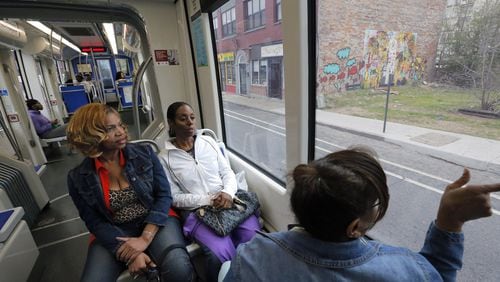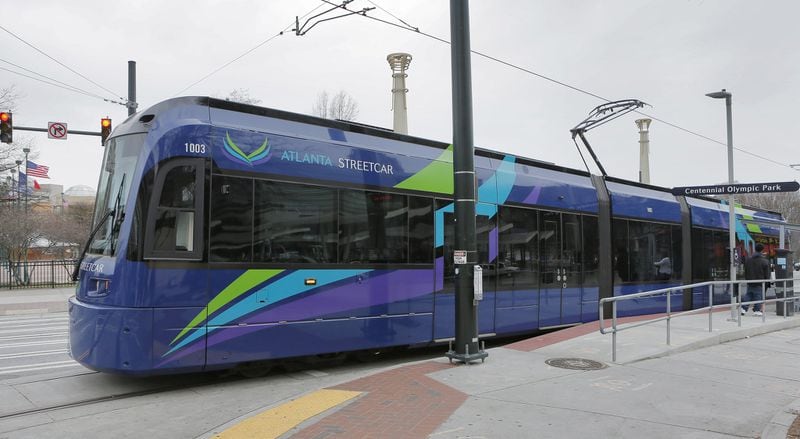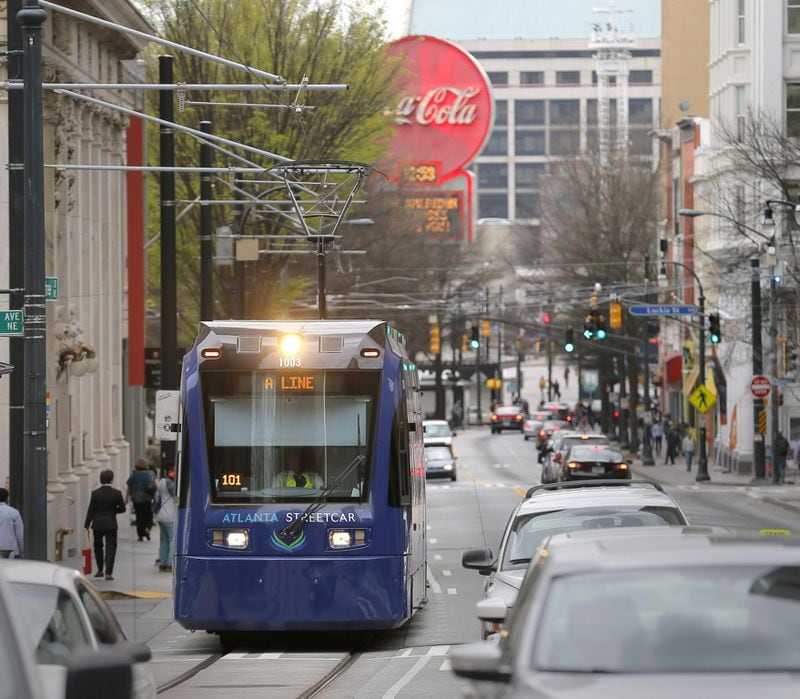The Atlanta Streetcar was short-staffed. Safety and security procedures were lax. Accidents were not properly investigated or reported. Defective equipment disrupted service.
Those were among the dozens of problems identified in a stinging audit of the $99 million project. More than a year later, the city has resolved fewer than one-third of those flaws, documents obtained by The Atlanta Journal-Constitution show.
And that isn't the only headache for the troubled streetcar, envisioned as a centerpiece of Atlanta's revitalization. Ridership fell nearly 60 percent last year after Atlanta began charging $1 to ride, federal statistics show. And the city estimates a third to a half of passengers still don't bother to pay.
WATCHDOG: Inside the Streetcar’s Rocky First Year
IN DEPTH: High-Impact Projects Loom Large in Atlanta region
Critics argue the streetcar is a failure and waste of taxpayers dollars — over budget, overhyped and underused – that should be abandoned.
Instead, Atlanta plans a major expansion.
Despite the rocky start, the city still hopes to use the existing 2.7-mile line as a launching point to create a 53-mile streetcar and light rail network across the city. It's a move that would cost billions of dollars, but supporters contend it's a long-term investment that will transform Atlanta as it expands, connecting to the Beltline and other attractions and drawing a new generation of workers and residents. The streetcar's problems, they argue, are the growing pains of a fledgling system.
“I think that over time it will prove successful, even with the toughest critics,” said A. J. Robinson, president of the Atlanta Downtown Improvement District, which helped pay for the streetcar. “If Atlanta wants to be competitive with the rest of the country … these are the types of investments you have to make.”
The February 2016 state audit found 66 problems with safety, security, maintenance and other aspects of streetcar operations. The city has completely resolved only 20 of those problems.
It’s unclear how soon officials will complete the rest of the items on the audit’s lengthy to-do list, which includes re-investigating accidents and improving law enforcement strategies, among other unfinished tasks. The Georgia Department of Transportation says the city is on track to finish the list by June. Atlanta officials say they hope to be done by then, but it could take longer.
Still, state officials say they're pleased with Atlanta's recent progress. GDOT has accepted Atlanta's plans to fix all of the outstanding issues raised in the audit. That's a big change from last spring, when the agency threatened to shut the streetcar down because Atlanta was not adequately addressing its concerns.
“They are headed in the right direction now,” GDOT Commissioner Russell McMurry said in a recent interview.
“It’s never ‘check the box and you’re done,’” McMurry said. “Like any kind of inspection or audit, there’s always things that need to be tweaked.”
“It’s just a tragedy for the City of Atlanta’s taxpayers,” said Benita Dodd, vice president of the fiscally conservative Georgia Public Policy Foundation. “What they’re looking for is expansion instead of admitting it’s such a failure.”
Great expectations
The Atlanta Streetcar debuted in December 2014 to great fanfare and high expectations.
The system runs on a 2.7-mie loop that connects Centennial Olympic Park, the King Center, Georgia State University and the Peachtree Center MARTA rail station. It’s a modest line as streetcars go – Portland, Ore., a city that Atlanta would like to emulate, has about 16 miles of streetcar railway. Critics say it’s sometimes faster to walk the line that to wait on a streetcar that winds through traffic.
But Atlanta eventually hopes to build a more than 50-mile streetcar and light rail network, including the 22-mile Atlanta Beltline. It's not entirely clear where the money would come from. Federal funding likely would be involved, and Atlanta voters last fall approved a new MARTA tax that could also be used.
Advocates say it would be an economic dynamo that would attract business investment, tourists and educated millennials with a taste for urban living.
At its inaugural run, Mayor Kasim Reed called the streetcar “a project that I believe will be a model for other cities across the United States of America.”
But even before its debut, some of the luster had come off. The budget ballooned from about $70 million to $98.9 million, in part because Reed insisted on buying new instead of used streetcars (a $47.6 million federal grant helped pay for the streetcar).
Later, the economic impact claims for the project came under scrutiny. Boosters said it had helped sparked hundreds of millions of dollars in nearby investment. But an AJC analysis found some of the major projects they cited — including the Georgia Aquarium's $110 million dolphin exhibit and the $70 million National Center for Civil and Human Rights — were conceived before the streetcar route was identified.
But audits by GDOT and the Federal Transit Administration cast the biggest shadow over the project. They found a slew of safety, operational, maintenance and personnel problems.
Half of safety-sensitive jobs were vacant and training was spotty. Streetcar operators weren’t tested for drugs and alcohol after accidents, as required. Problems with the streetcar’s overhead electrical system disrupted service.
The list went on and on. Auditors ultimately identified 66 problems and told the city to correct them.
Atlanta officials assured the public the streetcar was safe and the problems were being addressed. But GDOT officials became so concerned with the lack of progress that last May they threatened to shut down the system.
Credit: Bob Andres
Credit: Bob Andres
The city responds
Faced with a deadline to provide satisfactory responses, Atlanta submitted thousands of pages of documents to GDOT last summer, and the state withdrew its threat to shutter the streetcar.
Though Atlanta has closed out only 30 percent of audit issues, Public Works Commissioner William Johnson said it has made “huge progress.” A year ago, he said, GDOT had not accepted the city’s plans to address any of the problems.
“Now we’ve got 66 (accepted) and 20 that have been determined to be closed out,” said Johnson, a former Baltimore transportation director who came to Atlanta last May, just as GDOT threatened to shutter the streetcar. “That was a huge lift.”
Among its accomplishments: Auditors say the streetcar now is adequately staffed and has implemented a comprehensive training program. It’s also complied with hazard reporting rules and updated security and other plans.
Among the issues that are deemed incomplete: Atlanta must still re-investigate and re-submit all open accident and hazard investigations, coordinate with the Atlanta Police Department on law enforcement strategies and develop a long-term vehicle maintenance plan.
Still, GDOT praised the city in written responses to AJC questions about the streetcar’s progress.
“In the past six months, the Atlanta Streetcar has been transparent and responsive and we are encouraged by the progress that has been made,” the agency said.
An uncertain future
The streetcar’s future remains unclear. Johnson said the FTA will audit Atlanta later this year to gauge its progress.
Atlanta also is considering outsourcing streetcar operations to a private firm and is reviewing several proposals. Currently, it is staffed and run by city employees.
In the long term, Atlanta plans a dramatic streetcar expansion. Johnson said the city has begun discussions with MARTA and the Beltline on where the line should go next.
Robinson, the CID president, has some ideas. First, he’d like to see it go east to the proposed Beltline route and west to the new Falcons stadium.
“It needs to touch more places so that people can experience it more,” Robinson said.
Angela Gilliard of Oklahoma City shared that assessment. A native of Newnan, she rode the streetcar with friends recently while in town for a visit.
“I’m liking it,” Gilliard said, but added, “If it expands to the Beltline, then it will get more riders.”
But William Perry, executive director of Georgia Ethics Watchdogs, said Atlanta botched its chance to earn the public trust needed to justify an expansion. He said the city should have picked an initial route - perhaps along Peachtree Street - that would have served more passengers.
“You need to start with a successful piece so people support the vision,” Perry said. “I don’t think they’ve done that.”
Jeffrey Brown, chairman of the Department of Urban and Regional Planning at Florida State University, said start-up problems are not unusual among streetcar lines. But he said Atlanta seems to have had “a large number.”
Brown also is skeptical that streetcars are the economic development boon their advocates claim.
“There’s no rigorously done assessment of (streetcars’) effectiveness,” he said.
Robinson remains optimistic about the project. He sees a new bakery here and a new Starbucks there as evidence of the streetcar’s economic impact.
But Johnson said the real impact will come in the long run.
“We really didn’t build the streetcar for this generation,” he said. “In my opinion, it’s a long-term economic development and transit play.”
Credit: Bob Andres
Credit: Bob Andres
About the Author









